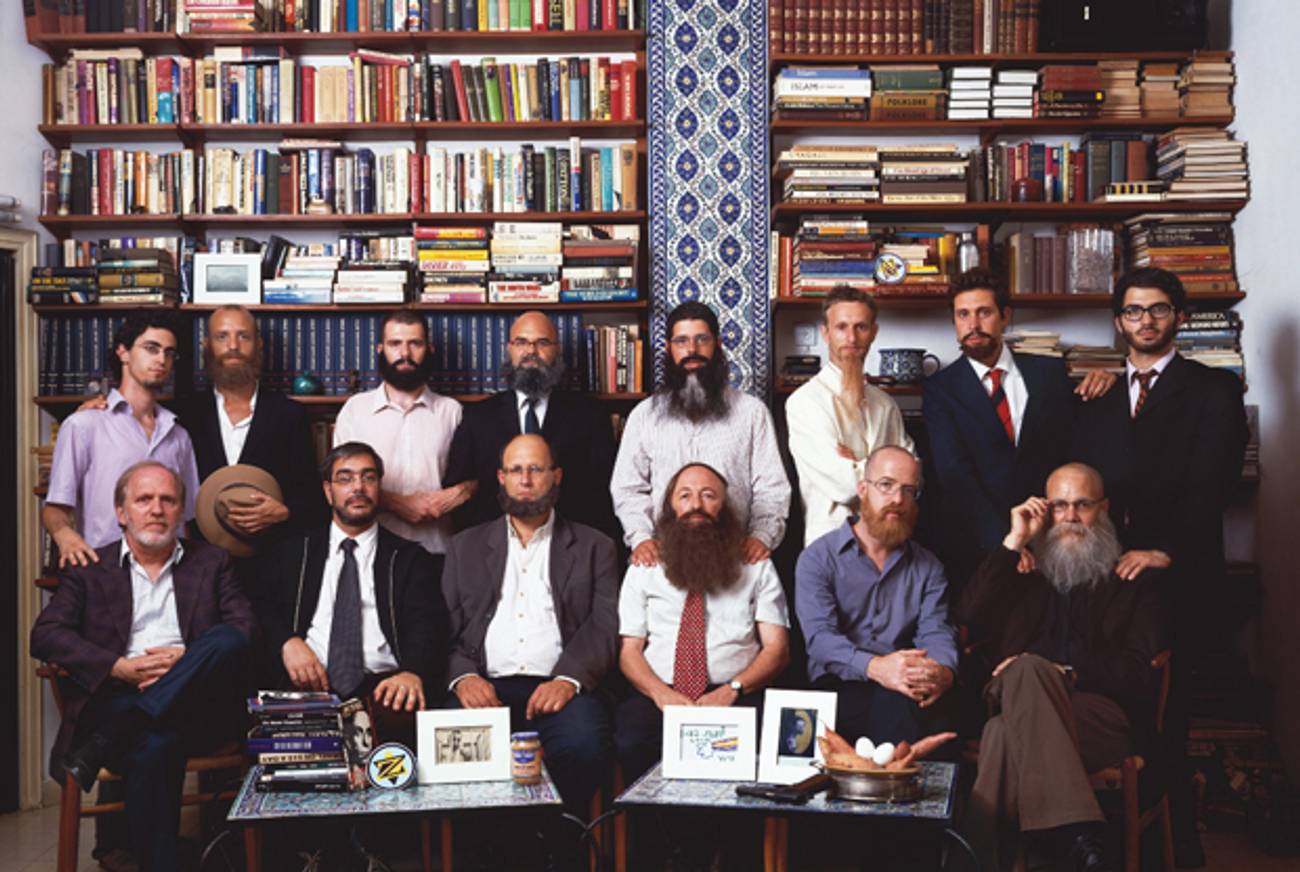On Display in Tel Aviv, the Art of Secular Judaism
New exhibit showcases artistic depictions of various forms of Jewish study




Gazing out from a large photograph by Israeli artist Roee Rosen are 14 bearded men surrounded by books. That these exaggeratedly hirsute men might be anything other than rabbis is, at first glance, improbable. But a closer look reveals that the men aren’t wearing skullcaps, most of their beards look glued on, and some of their faces seem oddly familiar: Doron Rabina, Yair Garbuz, and Boaz Arad are icons of the Israeli art scene, and Adi Ophir and Moshe Zuckermann are Tel Aviv University professors. They are spiritual leaders, but of a decidedly secular sort. It’s no surprise, then, that this is the photo that greets visitors to Secular Judaism, an exhibit that recently opened at the Nahum Gutman Museum of Art in Tel Aviv’s quaint Neve Tzedek neighborhood.
Directly across from the photo is the text of Achnai’s Oven, an old Talmudic legend recounting how a group of Babylonian rabbis asserted their independence from the heavens in regards to all manners of earthly halakhic interpretation, much to the delight and satisfaction of God himself (“My sons have defeated me,” he says, laughing). The exhibit explores how ever-growing strata in Israeli society have allowed individuals to take that independence even further, practicing a post-pious sort of Jewish study in secular batei midrash, and examining how this phenomenon has resonated with the local art world.
Nearly 40 works are on display in what amounts to something of an artistic grab bag: less the stuff of a strictly secular manifesto than a pluralistic exploration of the riches Judaism affords those willing to break the Third Commandment. Some of the works are ethnographic, such as those by Sagit Porat, who photographed prayer services at the egalitarian Beit Tefilah Israeli community in Tel Aviv, or documentary, as in Ohad Matalon’s image of Neturei Karta Litvaks brandishing anti-Zionist propaganda. Poetry adorns the walls, along with a series of four miniature video art pieces by Doron Solomon and Dina Shenhav, video stills with actors struggling to freeze as they reenact familiar Biblical scenes, such as the expulsion from Eden, or Jacob wrestling with the angel.
The nature of the art veers from the somberly political to the outlandishly humorous. Two works by Maya Cohen Levi superimpose religious texts from the Talmud and the Book of Job with written testimonies by Palestinians like Mahmud Rashid Hamed Salah, who had his olive trees cut down by settlers. The effect—black text on white text on a black background—is almost unreadable, but chilling nonetheless. On the other side of the gallery, “Rambam Bam Bam,” a music video by the band Metatron—helmed by Yovav Arazi and Jeremy Fogel and named for the archangel—channels both Subterranean Homesick Blues and ska. It toys repeatedly with the word Rambam, the acronym for Maimonides, as ultra-Orthodox children frolic on the Tel Aviv beach and a belly dancer does her thing.
At the room’s center there is space for visitors to conduct their own creative limmud of Jewish texts, with both classical and contemporary Jewish books available to peruse. Every other Tuesday, organizations such as the Hartman Institute, Alma, Elul, and Beit Daniel lead study sessions.
The largest work on display is a massive painting by Noam Wenkert titled “Self-portrait as Rabbi Shimon Bar Yochai.” Meeting Wenkert, as I did, adds to the appreciation of the work: she does not outwardly resemble her Rabbi Shimon, bushy-haired after twelve years spent in a cave, exiled by the Romans. The Talmud says that when Bar Yochai was finally allowed out, drunken with piety, his eyes set fire to people he thought were neglecting their Torah studies (a heavenly voice promptly ordered him back to his cave for another year). Wenkert spent much of her twenties as an activist in South Tel Aviv before deciding to pursue a career as an artist. “The conflict at the heart of my work,” she explained, “is between the desire to be an active part of the world, and the desire to be an artist, secluded in one’s cave. For me, Bar Yochai exemplifies that conflict.”
Tal Kra-Oz is a writer based in Tel Aviv.